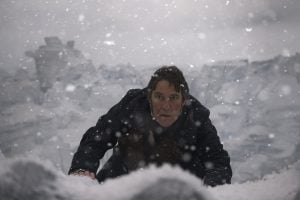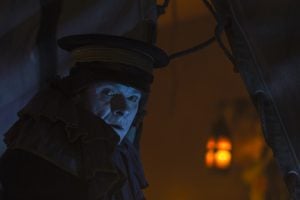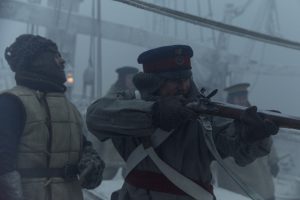
History
“The Terror” recap: Episodes 1 and 2
Our experts dissect the debut episodes of AMC’s new series about the Franklin Expedition
- 2258 words
- 10 minutes
This article is over 5 years old and may contain outdated information.
People & Culture

Every week, Stephen Smith and Russell Potter will review the latest episode of the AMC show The Terror for Canadian Geographic. Their take on the series’ ninth and penultimate episode — “The C, The C, The Open C” — appears below.
“We’ll make the best of a bad situation,” Cornelius Hickey tells his renegades this week, almost like a real leader whose management style doesn’t involve murdering the men under his command. Of course, in Hickey’s perverse glossary the best translates as the worst, and his judgment that the time has come for William Gibson to die is just one more dismal line defining the warp of his character.
Best and worst, stories and histories have this in common: they’re all about choices. Even by that understanding, though, The Terror does seem to serve up a particularly full menu this week.
We’re back in London, to start off, for the first time since episode four. Charles Dickens takes a quick turn, introducing Lady Jane Franklin and her brisk certainty that her husband and his men will be found — “and soon” — by the rescue mission she (unlike the Admiralty) is choosing to launch. The vigour of her pitch to the London Cultural Society is betrayed by the despair in Sophia Cracroft’s face — not to mention what we know of the situation back in the Canadian Arctic.
On King William Island, Lady Silence has a decision to make. Too many kabloona means that the Netsilik are now starving too. “The island gives us only wind now,” is the evocative phrase of the Elder she’s hearing from, and if she won’t call on Tuunbaq to rid the island of interlopers and restore the natural balance of things, then another shaman will have to do the job.
Kidnapped by Hickey, Dr. Goodsir has seen his choices narrowed nearly to none. It seems a long while back that I was wondering about the potential for confrontation between these two, and here we go. Goodsir is the grimmest we’ve seen him, weary, blank-eyed. He was kind, once, to Hickey, but in now refusing (at first) to serve as his camp butcher, he’s all contempt. “If you want to eat your friend,” he says, “you’re going to have to cut into him yourself.”
Hickey’s answer? “Don’t indulge your morals over your practicals.” He hasn’t lost his leer, or his talent for threats when cajolery doesn’t get him what he wants. Practicals prevail.
Not far away, Captain Crozier and his wretched loyalists are actually making the best of their situation, such as it is. Even as they’re dying, these men choose to go by way of mercy and respect, tenderness and dignity. If they can’t keep one another alive, they can care and comfort. As Captain Fitzjames comes to his sad end, John Bridgens (who’s not long from his) understands that his last duty to his commander is to muster the highest tribute he can. “You’re a good man,” he tells Fitzjames. “There will be poems.”
Thomas Blanky chooses sacrifice. When he can’t go on, he decides that he’ll do what he can for the greater good: lead Tuunbaq astray, maybe wound or even kill him. Alone at the shore somewhere down on what’s now known (on non-Inuit maps) as Graham Gore Peninsula, Terror’s ice-master has the bitter satisfaction of “discovering” the Northwest Passage while he waits for the inevitable. Knife in hand, clad in his ridiculous makeshift armour of forks, he’s found some kind of feisty peace. It even allows him a laugh as Tuunbaq comes on.
Two questions for you, Russell. In terms of the historical timeline that underlies this captivating fiction, we’re nearing the point where the actual expedition ceases to be, giving way to the legacy of bones and artifacts — ship’s boats and camp kettles, boots and Bibles and cutlery — that searchers such as Francis McClintock and John Rae would eventually track down. With Thomas Blanky and those forks in mind, I wonder how much attention you, as an historian, are paying to these sorts of details?
Interesting, too, to see Charles Dickens just as, back on King William Island, Hickey and his desperados are about to make Gibson their supper. I don’t know how much we’ll hear of it with the show’s finale approaching fast, but the novelist would make his own choice in the 1850s to attack John Rae while insisting that Franklin’s brave Englishmen would never have resorted to cannibalism. What are your thoughts on that?
As to the legacy of bones and artifacts, one of the great joys of the show has been to meet dramatic realizations of sailors known before only by way of some scratched initials or a monogrammed scrap of cloth. The officers’ silverware was at some point distributed to the men, many of whom etched their names or initials into them, and were among the first relics found and brought back by searchers; other items were marked as well.
Cornelius Hickey, interestingly, was the best-represented among these, getting his surname in a bone knife-handle as well as his initials on a spoon. Among the other men who left their marks were William Heather (a canteen), William Wentzell (a spoon), and Magnus Manson (a knife handle). The utensils also still bore their original family crests, of course, and among these Franklin’s was the most common, but Dr. Stanley, Graham Gore, John Irving, Henry Le Vesconte, George Hodgson, and Henry Goodsir were also represented. Perhaps the most poignant of all was the silverware of Lieutenant James Fairholme of the Erebus, which featured a crest with a sparrow and the Latin motto “SPERO MELIORA” — I hope for better things.
Of course, in the present program, a great many forks end up with Mr. Blanky, which at least provides a gruesome alternative explanation for the fact that some of these utensils were found heaped together near sites where the men had camped! Most of the recovered silverware is in storage at the National Maritime Museum in Greenwich, but several pieces — including Hickey’s knife-handle and a Fairholme fork — are part of the Death in the Ice exhibition, currently on display at the Canadian Museum of History in Gatineau; the exhibit will be travelling to the United States later this year, and will be shown at the Mystic Seaport Museum in Mystic, Conn., starting on Dec. 1.
As to Dickens, the scene with him is fanciful but certainly consistent with his feelings. Although I know of no evidence that he and Lady Franklin ever met, Dickens was an ardent follower of news of the expedition; to him, these men were unquestionably heroes. Which was why, when the Hudson’s Bay Company surveyor Dr. John Rae brought back Inuit testimony that the men had resorted to cannibalism, Dickens took the lead in attacking Rae’s account in the press as merely the untrustworthy babble of savages, a people “with a domesticity of blood and blubber” who would sooner murder Franklin’s men than help them. In fact, the shadow of this reactionary claim seems to lie beneath some of Hickey’s storyline, in which a man who regards other cultures as less than human shows himself more bestial than any beast.
Those interested in the Dickens angle would do well to get a hold of John Walker’s extraordinary documentary Passage, which shows that there are some, even today, who cling to the idea of hostile Inuit. The exchange in that film between Tagak Curley — an Inuit leader many regard as one of the founding fathers of the territory of Nunavut — and Dickens’s great-great-grandson Gerald, is a must-see. It’s a history that I think the producers of The Terror are keenly aware of, and hope to set right in a way by keeping their storyline true to Inuit culture and history, and unsparing in its portrait of the dark side of Western “civilization.”
Are you passionate about Canadian geography?
You can support Canadian Geographic in 3 ways:

History
Our experts dissect the debut episodes of AMC’s new series about the Franklin Expedition

History
Our experts continue their discussion of the AMC series about the Franklin Expedition

History
Our experts continue their discussion of the AMC series about the Franklin Expedition

History
Our experts continue their discussion of the AMC series about the Franklin Expedition